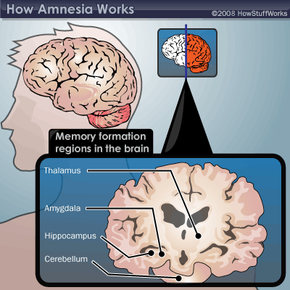The Process of Memory From Perception to Retrieval
Imagine for a moment what life would be like with a perfect memory. If you could remember each detail of everything taken in by your five senses, the first hour of the day would be mentally overwhelming -- truly too much information. That is why the brain sorts all of that data into your short-term memory or long-term memory or discards it.
Short-term memory allows us to retain information we need in the moment and then get rid of it. It's the mental equivalent of a takeout box. You use it to temporarily store small amounts of information and toss it afterward. Likewise, the short-term memory holds up to seven pieces of information for about 20 to 30 seconds [source: Canadian Institute of Neurosciences, Mental Health and Addiction]. Long-term memory is more like your internal freezer. It can hold information for years, or even a lifetime, but without some use, stuff in there can get "freezer burned."
Advertisement
We make and store memories by forging new neural pathways to the brain from things we take in through our five senses. The stimuli that our nerve cells detect, such as hearing a gunshot or tasting a raspberry, are called sensory memories. That sensory information flows along the nerve cells as an electrical impulse. As that impulse reaches the end of a nerve, it activates neurotransmitters, or chemical messengers. Those neurotransmitters send the message across the spaces between nerve cells called synapses and move it along to the neurons, or brain cells. If we need to immediately use that sensory information, it moves to the short-term memory, for example, when we hear a phone number and have to remember it to dial.
To turn short-term memories into long-term ones, our brains must encode, or define, the information. Remember that raspberry? Encoding it would likely include cataloging the fruit's size, tartness and color. From there, the brain cells would consolidate the information for storage by linking it to related memories. During this process, that neural pathway strengthens because of the brain's plasticity. Plasticity allows the brain to change shape to take in new information and, thus, new pathways.
Long-term memory retrieval requires revisiting the nerve pathways the brain formed. The strength of those pathways determines how quickly you recall the memory. To reinforce that initial memory, it must move multiple times across the nerve cells, retracing its steps.
Memory formation largely occurs in the brain's limbic system, which regulates learning, memory and emotions. The cortex is the temporary storage place of short-term memories and the area where the brain puts the new stimuli into context. The hippocampus then interprets the new information, associates it with previous memories and determines whether to encode it as a long-term memory. Next, the hippocampus sends the long-term memories to different areas of the cortex, depending on the type of memory. For instance, the amygdala houses intensely emotional memories. The memories are then stored in the synapses where they can be reactivated later.
Next, we'll see what happens when those neural pathways that make our memories are cut off by a roadblock called amnesia.
